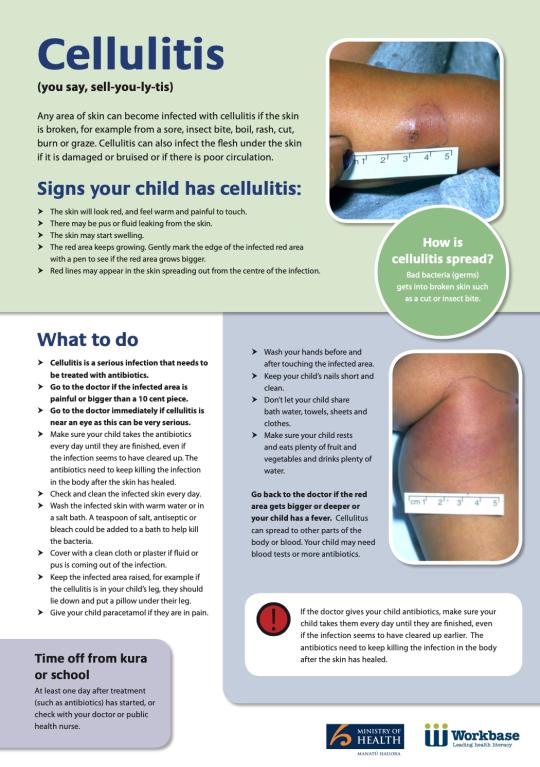Key points about cellulitis
- any area of skin can become infected with cellulitis
- cellulitis can develop from any break in the skin - even from something minor like an insect bite
- it can spread quite quickly
- cellulitis can be a serious infection - take your child to a health professional the same day
- tamariki (children) with cellulitis need treatment with antibiotics (by mouth)
- see a health professional immediately if cellulitis is near your child's eye - this can be very serious
What is cellulitis?
- cellulitis is an infection of the deeper layers of the skin
- it usually affects one area of the body
Causes of cellulitis
Cellulitis is caused by a bacterial infection. The bacteria are present on our skin all the time without causing infection. But, if they get through breaks in the skin, they can cause cellulitis. Cellulitis can get through breaks in the skin from:
- sores
- insect bites
- boils
- cuts
- burns
- grazes
- eczema
Sometimes the break in the skin is too small to notice.
Once the bacteria are in the skin, they cause redness and swelling that can spread rapidly.
You can't catch cellulitis from another person.
Signs and symptoms of cellulitis in children
- the area of the body with cellulitis will look red and swollen
- it will feel warm and is often painful to touch
- there may be pus or fluid leaking from the skin
- the red area keeps growing - gently mark the edge of the infected red area with a pen to see if the red area grows bigger
- red lines may appear in the skin spreading out from the centre of the infection
- your child may feel unwell and they may have a fever
When to get medical help for your child with cellulitis
When to see a health professional
Cellulitis can be a serious infection - take your child to a health professional the same day you suspect cellulitis.
Tamariki with cellulitis need treatment with antibiotics (by mouth).
When to seek immediate medical help
See a health professional immediately if cellulitis is near your child's eye - this can be very serious.
Go to the hospital or call 111 (in New Zealand) immediately if your child with cellulitis has:
- a very high temperature or they feel hot and shivery
- a fast heartbeat or fast breathing
- confusion
- drowsiness
- cold, clammy, pale skin
Treatment for cellulitis
For mild cellulitis affecting a small area of skin, a health professional will prescribe antibiotics (by mouth) for your child.
In more severe cases, your child may need to go to hospital for intravenous antibiotics (through a vein). Your child may also see an eye specialist (ophthalmologist) if the cellulitis is near their eye.
Antibiotics
Make sure your child takes the antibiotics every day until they are finished. It is important to do this even if the infection seems to have cleared up - there may be infection under the skin that you can't see.
The redness may continue to spread a little during the first 2 days of taking antibiotics. Go back to a health professional if the red area gets much bigger or your child has a fever or seems more unwell. Cellulitis can spread to other parts of the body or to the blood.
The health professional may mark the edge of the red area with a marker pen. Do not wash this off. This is to see if your child's skin infection is improving.
Wound care
If your child has a wound which led to the cellulitis, keep it clean and cover it with a dressing.
A health professional will tell you how to look after the wound at home.
Cellulitis does not cause pus. If your child has pus coming from their wound, tell a health professional. There may be an abscess that needs draining so the infection can get better.
Caring for your child with cellulitis at home
As well as taking antibiotics, some other things will also help.
Rest
Your child needs to rest. This helps their body fight the infection. If your child has cellulitis on their leg, try to stop them walking as much as you can.
Keep the affected area raised
Raise the affected part of your child's body on a pillow or chair when they're sitting or lying down.
You could use a sling when your child is walking around, if their arm or hand has cellulitis.
These help reduce swelling. Continue to do this for the first 48 hours at least.
Eat and drink normally
Encourage your child to eat and drink normally.
Pain relief
Cellulitis can be quite painful because it puts pressure on the skin from underneath. Your health professional will discuss appropriate pain relief and may give you a prescription.
Time off from kura or school
At least one day after treatment (such as antibiotics) has started, or check with your health professional.
Cellulitis resource for printing

